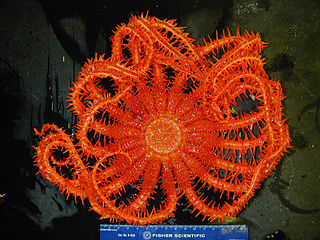
The Valvatida are an order of starfish in the class Asteroidea, which contains 695 species in 172 genera in 17 families.

The Echinasteridae are a family of starfish in the monotypic order Spinulosida. The family includes eight genera and about 133 species found on the seabed in various habitats around the world.

The Asterinidae are a large family of sea stars in the order Valvatida.

Astropecten is a genus of sea stars of the family Astropectinidae.

Goniasteridae constitute the largest family of sea stars, included in the order Valvatida. They are mostly deep-dwelling species, but the family also include several colorful shallow tropical species.

The Forcipulatida are an order of sea stars, containing three families and 49 genera.

Henricia is a large genus of slender-armed sea stars belonging to the family Echinasteridae. It contains about fifty species.

Astropecten irregularis is a sea star of the family Astropectinidae. Common names include Sand sea star.

The Brisingidae are a family of starfish found only in the deep sea. They inhabit both the Atlantic and Pacific Oceans at abyssal depths, and also occur in the Southern Ocean and around Antarctica at slightly shallower depths.

Poraniidae is a family of starfishes in the order Valvatida.

The Freyellidae are a family of deep-sea-dwelling starfish. It is one of two families in the order Brisingida. The majority of species in this family are found in Antarctic waters and near Australia. Other species have been found near New Zealand and the United States.

The Zoroasteridae are one of three families of Asteroidea in the order Forcipulatida. It contains seven living genera and one extinct genus.

Nepanthia is a genus of starfish of the family Asterinidae. Members of the genus have four to seven rays and are found in the eastern Pacific Ocean, ranging from Burma and Indonesia to Australia.
Paranepanthia is a genus of starfish of the family Asterinidae. Members of the genus have five rays and are found in the waters around Australia, Indonesia and Antarctic New Zealand.
Trophodiscus almus is a species of starfish in the family Astropectinidae. It is found in fairly deep waters in the Sea of Okhotsk, the Sea of Japan and around the Japanese island of Hokkaido. It is very unusual among starfish in that it broods its young on its upper surface. Its common name in Japanese is "Komochi-momiji".
Trophodiscus is a genus of starfish in the family Astropectinidae. There are only two species, both found in fairly deep waters in the Sea of Okhotsk. Trophodiscus almus is also found in the Sea of Japan and around the Japanese island of Hokkaido. These starfish are very unusual in that the young are brooded on the upper surface of the female.

Pterasteridae is a family of sea stars in the order Velatida, consisting of eight genera.

Freyella elegans is a species of deep-water starfish in the family Freyellidae in the order Brisingida, living at abyssal depths in the northwestern Atlantic Ocean.

Euretaster insignis, commonly known as the striking sea star, is a species of starfish in the family Pterasteridae found in the central west Pacific Ocean. It is one of only three species in the order Velatida to be found in shallow water in the tropics. The young are brooded in a cavity underneath a "supradorsal" membrane.

Astrolirus is a genus of echinoderms belonging to the family Brisingidae. They are found in benthic habitats in the Pacific Ocean.



















